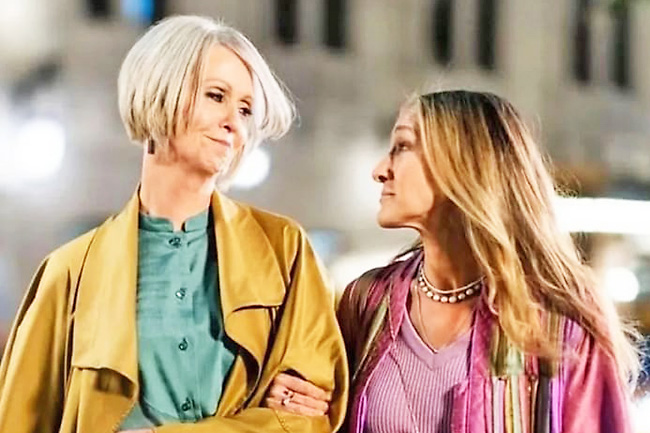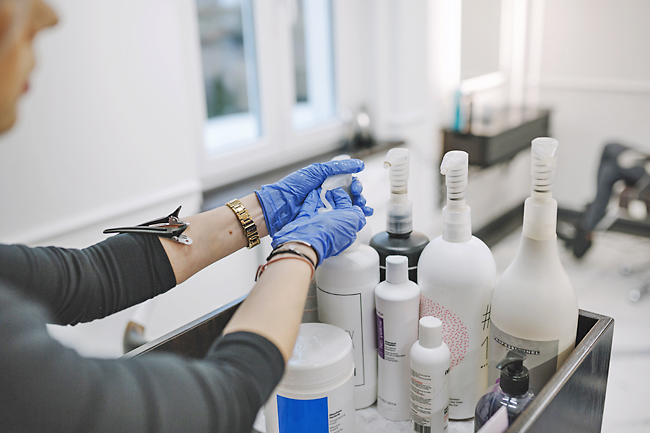Tatiana Boncompagni
CNA/THE NEW YORK TIMES – Even as some women embrace their naturally silvering tresses – consider Miranda Hobbes in And Just Like That, who abandons her trademark red in favour of a sleek, grey bob – laissez-faire attitude isn’t likely to extend to other changes women see in their hair as they get older.
Most people expect their hair to turn grey, but hair actually goes through myriad changes as we age, becoming less dense and more unruly, brittle and harder to grow long.
“Thick, shiny hair is a hallmark of youth,” said Dr Erika Schwartz, an integrative-medicine doctor who founded Evolved Science, a functional longevity practice in Manhattan that provides a variety of treatments to deal with thinning and lackluster locks. “Like everything else in ageing, your hair suffers the consequences.”
While many doctors are reporting a spike in thinning hair among patients who have had COVID-19 or are dealing with the stress of pandemic life (who isn’t?), hair loss and textural shifts related to getting older require a different approach to treat effectively.
Aside from getting hair transplants, “you can’t just do something and stop”, said Dr Gary Linkov, a hair restoration and facial plastic surgeon in Manhattan. “You have to keep it up if you want to maintain your results.”
Here, we answer some of the most pressing questions about what’s going on with your hair and what treatments and products may actually be worth trying.


WHAT EXACTLY HAPPENS TO HAIR AS WE GET OLDER?
For starters, there’s a loss of melanin, which is why hair becomes grey or white, said Dr Marnie Nussbaum, a dermatologist in Manhattan and the Hamptons.
When exactly that happens is often determined by genetics, as is whether or how much the hairline recedes or, as is more common for men than women, baldness occurs. Still, for almost everyone, the growth cycle slows, resulting in a longer resting or “telogen” phase of hair growth.
At the same time, changes in the follicle make each individual strand of hair emerge from the scalp thinner in diameter – a process often referred to as “miniaturisation”. The collective result is “overall more diffuse, thinner hair”, Nussbaum said.
But that’s not all. Hormonal shifts – specifically in women, less oestrogen and progesterone – also decrease the production of sebum, the natural emollient that coats hair and makes it appear shiny, Schwartz said.And because hair isn’t protected and moisturised, it is more prone to breakage and damage from heat styling and, say, colouring those greys.
SINCE I HIT 50, I CAN’T GROW MY HAIR PAST MY SHOULDERS. WHAT GIVES?
“I tell my patients they aren’t imagining it: Hair really does spend less time in the growth phase as we get older,” said a dermatologist in Manhattan Dr Dendy Engelman. Less time growing or more time resting means that “the hair will likely fall out before it reaches the desired length”, she said.
KeepItAnchored, a line of hair-care products, including a “leave-on scalp essence” shampoo and conditioner, introduced by Procter & Gamble in 2020, is aimed specifically at helping the scalp “hold on” to hair longer by combatting the effects of oxidative stress with antioxidants and zinc.
“Think of your scalp like parched earth. When it is dehydrated, hairs become less rooted,” said a principal scientist at Procter & Gamble and a founder of KeepItAnchored Jeni Thomas. “You can’t control your age and you can’t control your DNA, but you can control the scalp oxidative stress component of hair loss.”
MY HAIR IS FRIZZY AND UNMANAGEABLE ALL THE TIME. SHOULD I SWITCH PRODUCTS?
Possibly. “A lot of women have figured out what worked from them in their 30s, but then they’re hit with changes in their 40s and need to figure it out again,” said a scientist and engineer and head of product and innovation for Better Not Younger Debra Lin, a line of supplements and hair care products formulated to combat age-related hair concerns.
Lin recommends conditioners formulated with fatty acid-rich “plant butters” (think mango and macadamia nuts) and light oils made from sunflower seeds and camellias, for example, to smooth strands and decrease breakage without leaving hair looking greasy and limp.
Argan Oil Taming Serum from Hair Biology, a Procter & Gamble line that targets women over 50, uses argan oil and silicones to improve manageability of haywire strands, another complaint of many in the 50-plus set.
“We know that the fibre curvature of hair changes and gets less regular as we get older, but we don’t know exactly why that happens – just that it happens,” said Thomas, who is also a principal scientist behind Hair Biology. John Barrett, a hairstylist who tends Martha Stewart’s and Hillary Clinton’s trademark cuts at his Manhattan salon, advises clients to wash their hair no more than twice a week with gentle shampoo and to sleep in hydrating hair masks to improve manageability and shine. His mantra: Do less.
“Most hair problems are self-inflicted,” Barrett said.
WHAT ABOUT SHAMPOOS, SUPPLEMENTS AND SERUMS? DO THOSE THINGS ACTUALLY WORK?
They can, but choose wisely. Most specialty shampoos and serums, like the Scalp Stimulating Booster from Curlsmith, a haircare line headquartered in Britain, work by improving blood flow to follicles.
Curlsmith’s serum includes ginger and guarana, which have been shown to improve circulation, said Afope Atoyebi, a trichologist in London who has consulted for the company.
Linkov underscored that the only topical solution with significant medical research behind it is minoxidil, sold under the brand name Rogaine, which works by dilating blood vessels and may extend hair’s growth phase.
Some doctors are also prescribing topical finasteride, traditionally taken as a pill and better known by the brand name Propecia, which blocks testosterone from converting to DHT, an androgen (male sex hormone) that is linked to thinning hair in both men and women.
Finasteride should not be taken by women who are pregnant or could become pregnant.
Schwartz prescribes a compound serum made of finasteride, minoxidil and biotin to patients who are not going to become pregnant.
Supplements, likewise, can be helpful. Nutrafol, for example, makes a supplement that uses maca powder, saw palmetto and other ingredients to combat hair loss related to hormonal changes in perimenopause and menopause. Phase 1 of the company’s clinical trial of the supplement was recently published in the Journal Of Drugs In Dermatology.
“It has robust clinical studies and a reputation for good results among dermatologists,” said Dr Marina Peredo, a dermatologist in Manhattan and on Long Island.
Engelman likes Prose, which makes supplements that are tailored to age, hair type, lifestyle and other factors, and the prescription drug spironolactone, which is an androgen blocker and can also help with acne.






